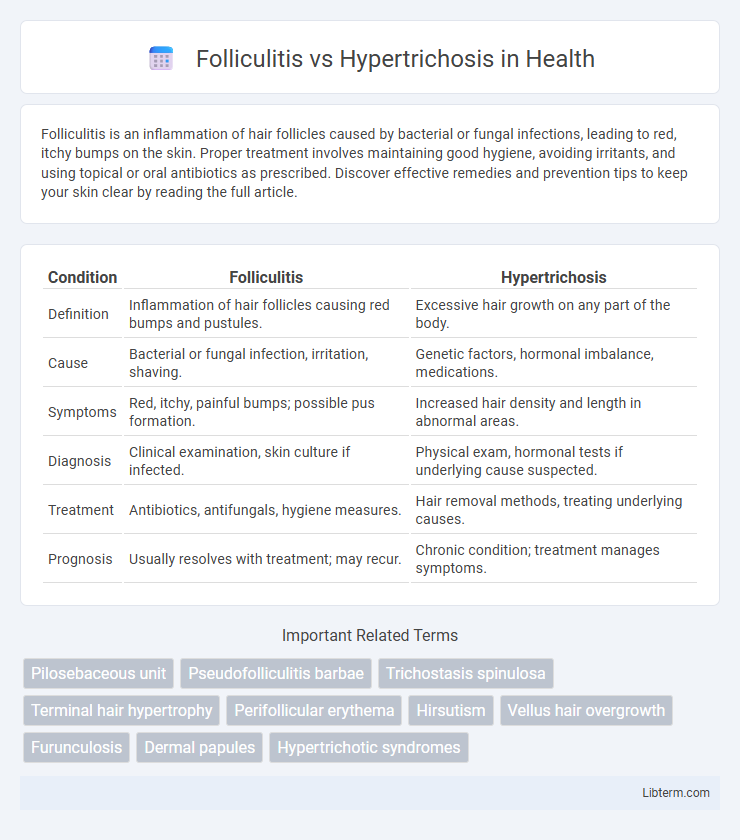Folliculitis is an inflammation of hair follicles caused by bacterial or fungal infections, leading to red, itchy bumps on the skin. Proper treatment involves maintaining good hygiene, avoiding irritants, and using topical or oral antibiotics as prescribed. Discover effective remedies and prevention tips to keep your skin clear by reading the full article.
Table of Comparison
| Condition | Folliculitis | Hypertrichosis |
|---|---|---|
| Definition | Inflammation of hair follicles causing red bumps and pustules. | Excessive hair growth on any part of the body. |
| Cause | Bacterial or fungal infection, irritation, shaving. | Genetic factors, hormonal imbalance, medications. |
| Symptoms | Red, itchy, painful bumps; possible pus formation. | Increased hair density and length in abnormal areas. |
| Diagnosis | Clinical examination, skin culture if infected. | Physical exam, hormonal tests if underlying cause suspected. |
| Treatment | Antibiotics, antifungals, hygiene measures. | Hair removal methods, treating underlying causes. |
| Prognosis | Usually resolves with treatment; may recur. | Chronic condition; treatment manages symptoms. |
Understanding Folliculitis: Definition and Causes
Folliculitis is an inflammation of hair follicles typically caused by bacterial or fungal infections, resulting in red, itchy, and sometimes painful bumps on the skin. Common triggers include shaving, friction from clothing, and clogged follicles due to oil or sweat buildup. Proper hygiene and topical treatments are crucial for managing folliculitis and preventing recurrent outbreaks.
What is Hypertrichosis? Key Characteristics
Hypertrichosis is a condition characterized by excessive hair growth on any part of the body, beyond what is normal for age, sex, and race. This abnormal hair growth can be localized or generalized, appearing in forms such as congenital, acquired, or drug-induced hypertrichosis. Key characteristics include thick, dark, and often coarse hair that may cover areas not typically associated with dense hair, unlike folliculitis which is an inflammation of hair follicles.
Clinical Presentation: Folliculitis vs Hypertrichosis
Folliculitis presents with inflamed, red, and tender hair follicles often accompanied by pustules or papules, primarily due to bacterial or fungal infection. Hypertrichosis features excessive hair growth in areas not typically hairy for the patient's age, sex, or ethnicity, without inflammation or follicular damage. Distinguishing folliculitis involves identifying follicular erythema and pustules, whereas hypertrichosis diagnosis relies on quantifying abnormal hair distribution and density.
Common Risk Factors for Folliculitis
Folliculitis commonly occurs due to bacterial infection, primarily Staphylococcus aureus, improper shaving techniques, and occlusive clothing that traps sweat and heat. Other risk factors include compromised immune systems, excessive sweating, and use of hot tubs or pools with inadequate sanitation. Unlike hypertrichosis, which involves excessive hair growth often linked to genetic or hormonal factors, folliculitis is an inflammatory condition affecting hair follicles caused by microbial invasion and mechanical irritation.
Primary Causes of Hypertrichosis
Hypertrichosis is primarily caused by genetic mutations, congenital syndromes, or metabolic disorders, leading to excessive hair growth beyond normal patterns. In contrast, folliculitis arises from bacterial, fungal, or viral infections that inflame hair follicles, often due to poor hygiene or irritation. Understanding hypertrichosis's roots in inherited or systemic conditions helps differentiate it from the infection-driven nature of folliculitis.
Diagnosis: Differentiating Folliculitis from Hypertrichosis
Differentiating folliculitis from hypertrichosis relies primarily on clinical examination and patient history. Folliculitis presents as inflamed, often pustular lesions around hair follicles, accompanied by itching or tenderness, while hypertrichosis is characterized by excessive hair growth without inflammation. Diagnostic tools such as dermoscopy or skin biopsy can further aid in distinguishing the follicular inflammation of folliculitis from the increased hair density seen in hypertrichosis.
Treatment Approaches for Folliculitis
Treatment approaches for folliculitis primarily include topical and oral antibiotics to combat bacterial infection, along with antiseptic washes like chlorhexidine to reduce microbial load. In cases caused by fungal agents, antifungal creams such as clotrimazole are prescribed, while warm compresses can help soothe inflamed hair follicles and promote drainage. Preventive measures involve maintaining proper hygiene, avoiding occlusive clothing, and minimizing shaving or using proper shaving techniques to reduce follicular trauma.
Management and Therapy Options for Hypertrichosis
Management of hypertrichosis primarily involves cosmetic approaches such as laser hair removal, electrolysis, and depilatory creams to reduce unwanted hair growth. Medical therapies may include topical eflornithine, which slows hair growth by inhibiting the enzyme ornithine decarboxylase. Addressing underlying causes, such as hormonal imbalances or medication side effects, is crucial for effective long-term control.
Prevention Tips: Reducing Risk of Folliculitis and Hypertrichosis
Maintaining proper hygiene and avoiding tight clothing helps reduce the risk of folliculitis by minimizing skin irritation and bacterial buildup around hair follicles. Using non-comedogenic skincare products and regularly exfoliating prevents clogged pores, which can contribute to both folliculitis and excessive hair growth associated with hypertrichosis. Incorporating these preventive measures supports healthy skin barrier function and regulates hair follicle health, lowering the likelihood of inflammation and abnormal hair growth.
When to Seek Medical Advice for Hair and Skin Disorders
Persistent itching, redness, or sores around hair follicles may indicate folliculitis requiring medical evaluation to prevent infection and scarring. Excessive, abnormal hair growth not linked to hormonal changes, known as hypertrichosis, warrants dermatological consultation to rule out underlying systemic conditions. Seek professional advice if hair or skin symptoms worsen, spread, or do not respond to over-the-counter treatments to ensure accurate diagnosis and targeted therapy.
Folliculitis Infographic

 libterm.com
libterm.com